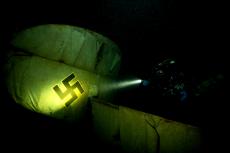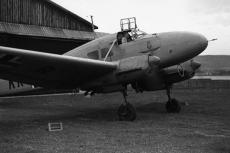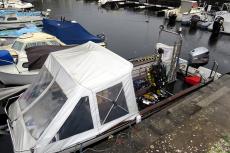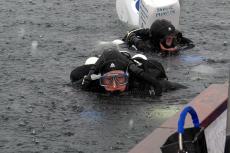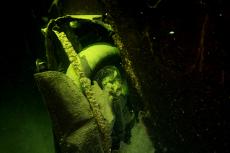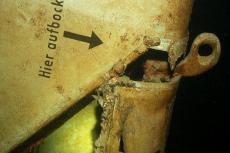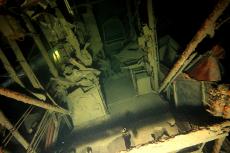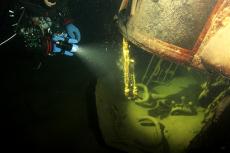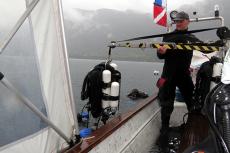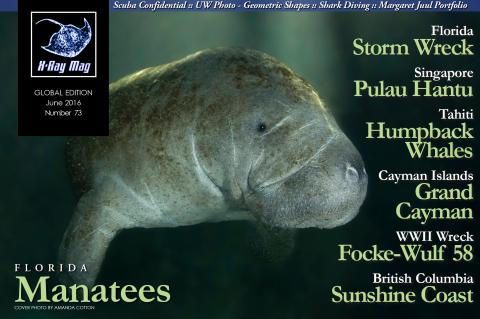France: Focke-Wulf 58 Wreck
There are places in the world where time seems to stand still, where you will find contemporary witnesses of events that can take your breath away. I visited just such a place more than 100 meters deep in a French lake—Lac du Bourget. Here, for more than 70 years, rests a Focke-Wulf Fw 58C—a German WWII airplane. This particular aircraft is one of the last of its kind that exist in the world.
On the nights of 26 and 27 November 1942, Airport Bruon in France was under German control. The Navigation School Number 4 of the 3rd Air Fleet was housed there. Young students were trained on the Focke-Wulf Fw 58C aircraft to become radio operators of the bomb squadron of the air force. The Focke-Wulf was used in WWII for the connection between the air bases in Bruon on Lac du Bourget and Lyon, and for monitoring the surrounding area.
On 30 March 1943 at 1:15p.m., a Focke-Wulf 58 with four men aboard took off. It was a training flight. They flew over the Alps, and after 40 minutes, passed the city of Chindrieux Châtillon before flying in a north-south path over the lake. On the last day of training, there was a tradition of flying at low altitude over the lake to celebrate the students’ passing of the course. Although this process was actually prohibited, the instructing pilot, Sergeant Ernst Chronz, flew this risky maneuver. For some reason, the plane hit the water surface and crashed. Two crew members were killed in the crash: the pilot, Sergeant Ernst Chronz, and student Corporal Kurt Becker. The second student, Rudolph Schiere, and Radio Corporal Otto Steinbach were miraculously rescued by fishermen, from drowning. The water temperature was at this time of year only 3°C (37°F). The shock and hypothermia made the immediate transport of the survivors impossible. The German airmen were taken by the villagers of Conjux and given shelter. Later, to thank the villagers for their assistance, the German commander had four prisoners of war, who were citizens of Conjux, freed.
Many decades later, the history of the plane crash in the lake was forgotten by the community. So no one knew the exact position of the wreck. In 1988, it was discovered after intensive research by a group of French researchers. However, the depth and conditions of the wreck site made a dive to the downed aircraft impossible at that time. Only in 2004 did three open circuit trimix divers venture a first expedition down to the wreck, resting at 117m. What they found surpassed all expectations.
My story
It has been some years since I first heard of the Focke-Wulf 58 wreck in Lac de Bourget. Two friends of mine had received an invitation to dive it and were very enthusiastic about this special experience. At that time, I could not really understand their excitement. It was several years later, that I was able to perform dives to depths of 100m.
In spring 2012, I learned about a deep wreck expedition in southern Sardinia led by Philippe Gathiard. I found out from Philippe that he operates a dive shop in Bourget du Lac, and since 2006, has led selected technical divers on dives to the wreck of Focke-Wulf 58 several times a year.
Typically, he does not take anyone he does not know, or was not recommended to him by his friends. I received a personal invitation from him and was counted among the few he selected who were allowed to visit the wreck on the bottom of the lake on the last Sunday in October 2012.
On Saturday afternoon, I made the four-hour road-trip from my home in Switzerland to Chambery, France. On the way through Switzerland, winter took me by surprise. There was a severe storm that lasted through Saturday night to Sunday morning. On Sunday morning at 8:00 a.m., my dive colleagues and I met Philippe at the dive center, and he said we would not be able to dive the wreck site. He drove us to the port where we could see with our own eyes that an exit would have been impossible; the storm had surprised many boat owners. The boats that had not made it back to the safety of the harbor lay partly upside-down on the shore.
Exactly one year would pass before I got another chance. This time, I even had the good luck of knowing all the divers on the trip. There were six of us, including two dive colleagues who had traveled all the way from England to dive the wreck. As Philippe spoke only French, I was very happy that Severine Bar was one of our party, as she greatly facilitated communications with Philippe. Moreover, Severine and another diver in our party, Frank, had already dived the wreck several times. The whole group met in Chambery the evening before the dive, so we had time to go through the planning for the next day at our leisure.
Sunday morning at 8:00 a.m., we met with Philippe at the dive center. After all the formalities were done, we were given a detailed briefing. During the briefing, Philippe took advantage of some very good posters and pictures of the wreck. He repeatedly pointed out to us the extreme conditions under which we would perform this dive. It would be dark and cold, and quite possibly, we could expect poor visibility.
Over 100m down
After a hearty breakfast at the bakery next to the dive center, we made our way to the harbor. It was a cold, cloudy day and it was raining. We stowed the dive equipment on Philippe’s small boat. With six rebreathers, 24 stage bottles, a decompression station and some spare bottles, the capacity of the boat was quickly exhausted. In an hour, we got to the dive site. Once there, Philippe found the buoy with the shotline, which was moored in about 2m (6ft) of water.
Due to the size of the boat, we made three dive teams to do the dive successively. In the first team were our English friends. Oliver Perschke and I formed the second group, and Severine and Frank were the final group to enter the water.
The dive
Oliver and I descended along the shotline. The visibility was good but it grew dark quickly. At a depth of 95m (312ft), we reached the tail of the aircraft. I got a shiver down my spine when I saw the swastika symbol, which was lit up by my torch. It looked like it had been painted on the airplane only yesterday.
Next, we saw the tail. We continued along the fuselage to descend toward the cockpit. The two wings were still firmly attached to the airplane and extended from the base at right angles to the surface. The shell of the aircraft was only partially preserved. In some places, it hung down, giving us a view of the aircraft’s inner workings and control dials.
It was hard to believe, but even after more than 70 years on the bottom of the lake, we could still clearly read the labels. On the wings, we read, “Do not tread on” and “Do not touch”.
The nose and part of the cockpit were stuck in the mud. On the bottom, we could see parts of the landing gear and into the cockpit seat, as well as some other details of the airplane. Unfortunately, the visibility was very poor so close to the bottom, so I could not see everything clearly.
Slowly, we turned and began the ascent. Swimming along the body of the aircraft, which was only a skeleton, we returned to the impressive, challenging part of the wreck: the rear, with its large swastikas.
After 18 minutes of bottom time, it was time to say goodbye to the Focke-Wulf 58. Philippe had given us a maximum time of 140 minutes. Oliver, Severine, Frank and I adhered precisely to this requirement. Our English friends, however, dived for nearly three hours before returning to recharge.
On the surface, we were assisted with stowing our equipment. Philippe picked up everything out of the water using a small crane, lifting our equipment back into the boat.
Afterthoughts
The dive to the Focke-Wulf wreck was fantastic, and I would have liked to have repeated it the following year. Unfortunately, Philippe’s boat was sold and he no longer offers diving to the Focke-Wulf 58 anymore. ■
Vimeo.com/80744575. For more information on the dive center, visit: HelioxPlongee.fr.
Sabine Kerkau is a German technical diver, dive writer and underwater photographer based in Switzerland. For more information, please visit: Sabine-Kerkau.com.
Download the full article ⬇︎
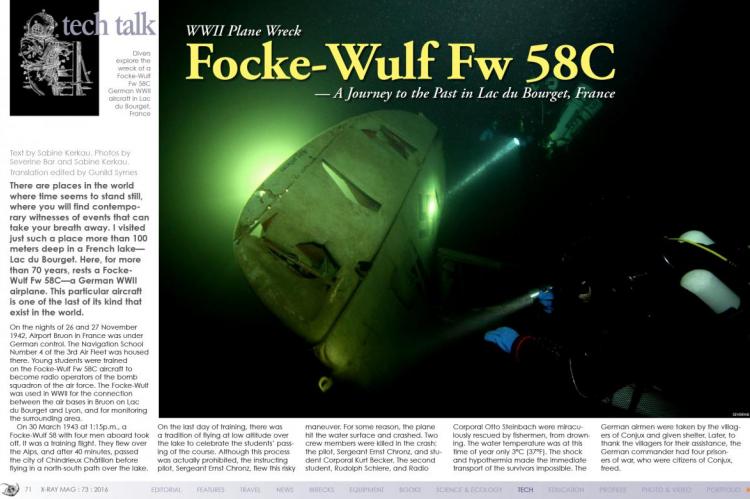
Originally published
X-Ray Mag #73
Florida manatees of Crystal River; Florida's Storm Wreck; Singapore's Pulau Hantu; Tahiti's humpback whales; Grand Cayman Island; Focke-Wulf 58 WWII wreck; BC's Sunshine Coast; Annapolis wreck anniversary; Scuba Confidential: Checkout dives; Shark diving: Tips on photographing sharks; In search of seahorses; UW Photo: Geometric shapes; Margaret Juul portfolio; Plus news and discoveries, equipment and training news, books and media, underwater photo and video equipment, shark tales, whale tales and much more...



